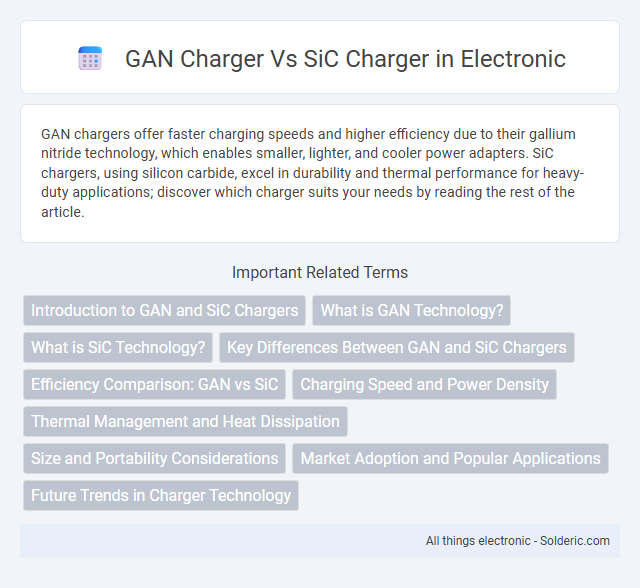GAN chargers offer faster charging speeds and higher efficiency due to their gallium nitride technology, which enables smaller, lighter, and cooler power adapters. SiC chargers, using silicon carbide, excel in durability and thermal performance for heavy-duty applications; discover which charger suits your needs by reading the rest of the article.
Comparison Table
| Feature | GaN Charger | SiC Charger |
|---|---|---|
| Material | Gallium Nitride (GaN) | Silicon Carbide (SiC) |
| Efficiency | Up to 95%+ | Up to 97%+ |
| Size | Compact, lightweight | Moderate size |
| Thermal Performance | Good heat dissipation, lower heat generation | Excellent heat tolerance, high temperature operation |
| Power Density | High power density suitable for fast chargers | Higher power density, ideal for high power industrial chargers |
| Cost | Moderate, becoming more affordable | Higher cost due to complex manufacturing |
| Applications | Consumer electronics, fast phone and laptop chargers | Electric vehicles, industrial power systems, high voltage chargers |
| Switching Frequency | High switching frequency (~MHz range) | Moderate switching frequency (kHz to low MHz) |
Introduction to GAN and SiC Chargers
GaN chargers utilize gallium nitride semiconductors, offering higher efficiency and faster charging speeds compared to traditional silicon-based chargers due to their superior electron mobility and thermal conductivity. SiC chargers, based on silicon carbide technology, excel in high-power applications with enhanced durability and lower energy losses, making them ideal for robust and heavy-duty charging requirements. Your choice between GaN and SiC chargers depends on whether you prioritize compact, rapid charging or high-power performance and long-term reliability.
What is GAN Technology?
GAN (Gallium Nitride) technology uses a semiconductor material that enables higher efficiency and faster charging speeds compared to traditional silicon-based chargers. GAN chargers feature smaller, lighter designs with improved thermal performance, allowing for compact and powerful power adapters. This technology supports higher switching frequencies, contributing to reduced energy loss and enhanced overall charger efficiency.
What is SiC Technology?
SiC (Silicon Carbide) technology uses semiconductor materials that enable higher efficiency and faster switching speeds compared to traditional silicon-based components in chargers. SiC chargers offer improved thermal conductivity and reduced power loss, allowing for smaller, lighter, and more durable power adapters. This technology enhances charging performance by enabling higher voltage operation and better heat dissipation, making SiC chargers ideal for fast-charging applications.
Key Differences Between GAN and SiC Chargers
GaN chargers use gallium nitride semiconductors that enable higher efficiency and smaller size compared to traditional silicon, while SiC chargers leverage silicon carbide for superior thermal conductivity and higher voltage handling. You'll notice GaN chargers excel in compact, lightweight designs suited for fast-charging small devices, whereas SiC chargers are preferred for industrial applications requiring robust performance and durability. Key differences include GaN's faster switching speeds versus SiC's enhanced heat resistance and voltage tolerance.
Efficiency Comparison: GAN vs SiC
GaN chargers offer higher efficiency due to faster switching speeds and lower power losses, typically achieving efficiencies above 95%, making them ideal for compact, high-power applications. SiC chargers excel in high-voltage and high-temperature environments, maintaining robust efficiency around 94-96% while providing superior thermal management and durability. Your choice between GaN and SiC chargers should consider specific efficiency needs relative to power levels and operating conditions.
Charging Speed and Power Density
GaN chargers deliver higher charging speeds than traditional SiC chargers due to their superior electron mobility, enabling faster power transfer and reduced heat generation. Power density in GaN chargers is significantly greater, allowing more compact and lightweight designs without sacrificing performance. SiC chargers, while robust and efficient at high voltages, typically feature lower power density and slower charging rates compared to GaN counterparts.
Thermal Management and Heat Dissipation
GaN chargers exhibit superior thermal management due to their higher efficiency and lower internal resistance, resulting in less heat generation compared to SiC chargers. SiC chargers, while robust and capable of handling high voltages, tend to produce more heat that requires advanced cooling solutions to maintain optimal performance. Effective heat dissipation in GaN chargers allows for smaller, lighter designs with improved reliability and longer lifespan.
Size and Portability Considerations
GaN chargers are significantly smaller and lighter than SiC chargers due to their ability to handle higher switching frequencies with less heat generation, enabling compact and portable designs. SiC chargers, while efficient at high power levels, typically require larger heat sinks and bulkier components, resulting in increased size and reduced portability. For users prioritizing travel convenience and space-saving, GaN chargers offer a clear advantage in size and ease of transport.
Market Adoption and Popular Applications
GaN chargers have rapidly gained market adoption due to their compact size, high efficiency, and cost-effectiveness, making them popular for consumer electronics like smartphones and laptops. SiC chargers, though more expensive, dominate industrial applications requiring higher power levels and durability, such as electric vehicle fast charging and renewable energy systems. Your choice depends on whether you prioritize portability and affordability (GaN) or rugged performance and high power handling (SiC).
Future Trends in Charger Technology
GaN chargers are gaining traction for their compact size and high efficiency, supporting faster charging speeds and enhanced thermal performance. SiC chargers excel in high-power applications due to superior heat tolerance and durability, making them ideal for electric vehicle fast chargers and industrial uses. Future trends suggest hybrid solutions leveraging GaN's power density and SiC's robust performance will dominate the charger technology market, driving innovations in energy-efficient, high-speed charging systems.
GAN charger vs SiC charger Infographic

 solderic.com
solderic.com